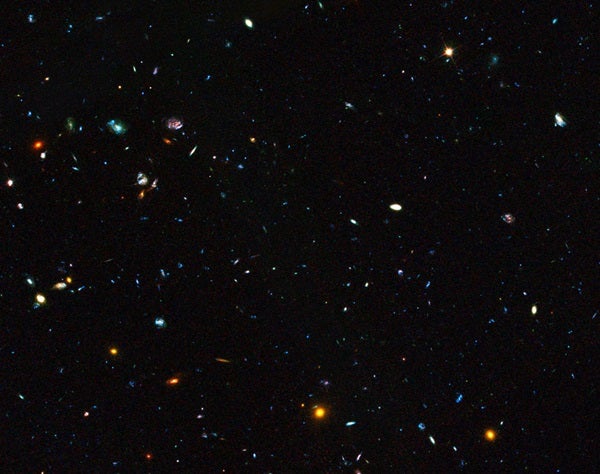Hiding amongst these thousands of galaxies are faint dwarf galaxies that reside in the early universe between 2 and 6 billion years after the Big Bang, an important time period when most of the stars in the universe were formed. Some of these galaxies are undergoing starbursts and have been studied by astronomers to deduce their contribution to star formation in this crucial era of the universe’s history.
The image is part of the Great Observatories Origins Deep Survey (GOODS), and this image shows only one section that the survey covered.
Although galaxies across the universe are still forming new stars, the majority were formed between 2 and 6 billion years after the Big Bang. Studying this early epoch of the universe’s history is key in order to fully understand how these stars formed and how galaxies have grown and evolved since.
A new study using data from Hubble’s Wide Field Camera 3 (WFC3) has allowed astronomers to take a new step forward in understanding this crucial era by peering at a sample of dwarf galaxies in the early universe and, in particular, a selection of starburst galaxies within this sample. These starburst galaxies form stars at a furiously fast rate, far above the “normal” star formation rate expected of galaxies. Previous studies of starburst galaxies have focused on analyzing mid-range or high-mass galaxies, leaving out the huge number of dwarf galaxies that existed in this era of prolific star formation.
It was not previously possible to study these distant small galaxies closely. Astronomers could only observe small galaxies at smaller distances or larger galaxies at greater distances. The highly sensitive infrared capabilities of WFC3 and its unique grism spectroscopy mode, though, have now allowed astronomers to peer at low-mass dwarf galaxies in the distant universe and to deduce the contribution of the starburst galaxies to the total star formation within dwarf galaxies at that time.
“We already suspected that dwarf starbursting galaxies would contribute to the early wave of star formation, but this is the first time we’ve been able to measure the effect they actually had,” said Hakim Atek of the École Polytechnique Federale de Lausanne (EPFL) in Switzerland. “They appear to have had a surprisingly significant role to play during the epoch where the universe formed most of its stars.”
“These galaxies are forming stars so quickly that they could actually double their entire mass of stars in only 150 million years. This sort of gain in stellar mass would take most normal galaxies 1–3 billion years,” said Jean-Paul Kneib of EPFL.
This result contributes to a decade-long investigation to understand the links between galaxies’ mass and their star-forming activity and helps paint a consistent picture of events in the early universe.
As well as adding new insight into how and where the stars in our universe formed, this new finding will certainly help unravel the secrets of galactic evolution. It is unusual to find a galaxy in a state of starburst, implying that they are the result of some strange incident, such as a merger, a tidal interaction with another galaxy, or the shock wave from a supernova. By studying these galaxies more closely and understanding how they formed and behaved in their earliest years, astronomers hope to discover the cause of these violent bursts and learn more about galactic evolution throughout the universe.










